All Exams >
JAMB >
Physics for JAMB >
All Questions
All questions of Conduction of Energy through Liquids & Gases for JAMB Exam
When Al2O3 is electrolysed ,cation and anions are discharged. For a given quantity of electricity,ratio of number of moles of Al and O2 gas is - a)1 : 1
- b)2 : 1
- c)2 : 3
- d)4 : 3
Correct answer is option 'D'. Can you explain this answer?
When Al2O3 is electrolysed ,cation and anions are discharged. For a given quantity of electricity,ratio of number of moles of Al and O2 gas is
a)
1 : 1
b)
2 : 1
c)
2 : 3
d)
4 : 3
|
|
Niti Mishra answered |
When same quantity of electricity is passed, elements/gases are formed in the ratio of their equivalents
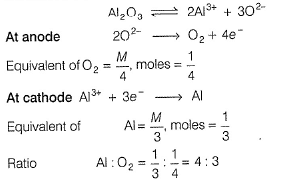 .
.
Only One Option Correct TypeThis section contains 16 multiple choice questions. Each question has four choices (a), (b), (c) and (d), out of which ONLY ONE is correctQ. During the electrolysis of aqueous Zn(NO3)2 solution- a)Zn plates out at the cathode
- b)Zn plates out at the anode
- c)H2 gas is evolved at the anode
- d)O2 gas is evolved at the anode
Correct answer is option 'D'. Can you explain this answer?
Only One Option Correct Type
This section contains 16 multiple choice questions. Each question has four choices (a), (b), (c) and (d), out of which ONLY ONE is correct
Q.
During the electrolysis of aqueous Zn(NO3)2 solution
a)
Zn plates out at the cathode
b)
Zn plates out at the anode
c)
H2 gas is evolved at the anode
d)
O2 gas is evolved at the anode

|
Gauri Khanna answered |
In preference to reduction of Zn2+ at cathode, O2- (aq) is oxidised to O2 at anode.
In the electrorefining of metals, impure metal is- a)cathode and oxidation taken place
- b)anode and oxidation takes place
- c)anode and reduction takes place
- d)cathode and reduction takes place
Correct answer is option 'B'. Can you explain this answer?
In the electrorefining of metals, impure metal is
a)
cathode and oxidation taken place
b)
anode and oxidation takes place
c)
anode and reduction takes place
d)
cathode and reduction takes place

|
Ameya Basu answered |
Electrorefining of Metals:
In the electrorefining process, impure metal is purified through electrolysis.
Impure Metal as Anode:
- In electrorefining, the impure metal is attached to the anode.
- The anode undergoes oxidation, where the impurities present in the metal are oxidized and dissolve into the electrolyte.
- This leaves behind a more pure form of the metal at the cathode.
Therefore, the correct statement is:
Option B: Anode and oxidation takes place
In the electrorefining process, impure metal is purified through electrolysis.
Impure Metal as Anode:
- In electrorefining, the impure metal is attached to the anode.
- The anode undergoes oxidation, where the impurities present in the metal are oxidized and dissolve into the electrolyte.
- This leaves behind a more pure form of the metal at the cathode.
Therefore, the correct statement is:
Option B: Anode and oxidation takes place
A solution of copper(II) sulphate (VI) is electrolysed between copper electrodes by a currrent of 10.0 A for exactly 9650 s.Which remains unchanged?- a)Molar concentration of solution
- b)Cathodic plate
- c)Anodic plate
- d)All of these
Correct answer is option 'A'. Can you explain this answer?
A solution of copper(II) sulphate (VI) is electrolysed between copper electrodes by a currrent of 10.0 A for exactly 9650 s.Which remains unchanged?
a)
Molar concentration of solution
b)
Cathodic plate
c)
Anodic plate
d)
All of these

|
Ishani Patel answered |
0.5 mole of copper is dissolved from the anode. Thus, its mass decreases. 0.5 mole of copper from the anode is deposited at the cathode. Thus, its mass increases.
Thus, molar concentration of aqueous solution of CuSO4 remains unchanged.
100 mL of a buffer of 1 M NH3(aq) and 1 M NH4+(aq) are placed in two volatic cells separately.A current of 1.5 A is passed through both cells for 20 min. If electrolysis of water only takes place2H2O +O2 + 4e- → 4OH- (RHS2H2O → 4H+. + O2 + 4e- (LHS)then pH of the - a)LHS half-cell will increase
- b)RHS half-cell will increase
- c)both half-cell will increase
- d)both half-cell will decrease
Correct answer is option 'B'. Can you explain this answer?
100 mL of a buffer of 1 M NH3(aq) and 1 M NH4+(aq) are placed in two volatic cells separately.A current of 1.5 A is passed through both cells for 20 min. If electrolysis of water only takes place
2H2O +O2 + 4e- → 4OH- (RHS
2H2O → 4H+. + O2 + 4e- (LHS)
then pH of the
a)
LHS half-cell will increase
b)
RHS half-cell will increase
c)
both half-cell will increase
d)
both half-cell will decrease

|
Sinjini Tiwari answered |
In RHS, [NH3] increases hence, pOH decreases
pH = 14 - pOH
Hence, pH of RHS increases.
In LHS, [NH4+] increases, hence pOH increases and pH decreases.
In a fuel cell, following reactions takes place and electricity is produced. AnodicH2+2OH- → 2H2O + 2e-CathodicO2+2H2O + 4e- → 4OH-If 100.8 L of H2 at STP reacts in 96500 s,what is the average current produced (in ampere)? - a)1.0 mol
- b)2.0 mol
- c)3.0 mol
- d)4.0 mol
Correct answer is '9'. Can you explain this answer?
In a fuel cell, following reactions takes place and electricity is produced.
Anodic
H2+2OH- → 2H2O + 2e-
Cathodic
O2+2H2O + 4e- → 4OH-
If 100.8 L of H2 at STP reacts in 96500 s,what is the average current produced (in ampere)?
a)
1.0 mol
b)
2.0 mol
c)
3.0 mol
d)
4.0 mol

|
Anoushka Chopra answered |
Select the correct observation about electrolysis.- a)Electric current is used to drive a non-spontaneous reaction
- b)Ecell is positive and ΔG is negative
- c)Cations and anions are discharged at the cathode and anode respectively
- d)Overvoltage is responsible that a particular reaction takes place
Correct answer is option 'A,C,D'. Can you explain this answer?
Select the correct observation about electrolysis.
a)
Electric current is used to drive a non-spontaneous reaction
b)
Ecell is positive and ΔG is negative
c)
Cations and anions are discharged at the cathode and anode respectively
d)
Overvoltage is responsible that a particular reaction takes place
|
|
Shalini Choudhary answered |

Thus, electric current is used to carry out a non-spontaneous reaction.
Thus. (a) is correct.
(b) Since reactions are reverse of electrochemical cell, hence
Thus. (a) is correct.
(b) Since reactions are reverse of electrochemical cell, hence

thus, (b) is incorrect
(c) cation goes to cathode and anion goes to anode and are discharged. Thus, correct

(d) some additional voltage called overvoltage is set up and thus other reactions also take place. thus correct
Passage IIIn hydrogen economy fuel-cell,anodic and cathodic reactions are AnodicH2+2OH- → 2H2O + 2e-CathodicO2+2H2O + 2e- → 4OH-67.2 L H2 at STP react in 15 min.Entire current is used for electro deposition of copper from copper(II) sulphate solution. Average current produced in fuel cell is - a)610.00 A
- b)620.00 A
- c)617.8 A
- d)643.3 A
Correct answer is option 'D'. Can you explain this answer?
Passage II
In hydrogen economy fuel-cell,anodic and cathodic reactions are
Anodic
H2+2OH- → 2H2O + 2e-
Cathodic
O2+2H2O + 2e- → 4OH-
67.2 L H2 at STP react in 15 min.Entire current is used for electro deposition of copper from copper(II) sulphate solution. Average current produced in fuel cell is
a)
610.00 A
b)
620.00 A
c)
617.8 A
d)
643.3 A

|
Shraddha Gupta answered |
1 Faraday of electricity is passed through the solution containing 1 mole each of AgNO3, CuSO4, AlCl3 and SiCl4. Elements are discharged at the cathode.Number of moles of Ag, Cu,Al and Si formed will be in the ratio of - a)1 : 1 : 1 : 1
- b)1 : 2 : 3 : 4
- c)6 : 4 : 3 : 1
- d)12 : 6 : 4 : 3
Correct answer is option 'D'. Can you explain this answer?
1 Faraday of electricity is passed through the solution containing 1 mole each of AgNO3, CuSO4, AlCl3 and SiCl4. Elements are discharged at the cathode.Number of moles of Ag, Cu,Al and Si formed will be in the ratio of
a)
1 : 1 : 1 : 1
b)
1 : 2 : 3 : 4
c)
6 : 4 : 3 : 1
d)
12 : 6 : 4 : 3
|
|
Aarya Khanna answered |
Explanation:
To solve this problem, we need to determine the moles of each element formed at the cathode when 1 Faraday of electricity is passed through the solution containing 1 mole each of AgNO3, CuSO4, AlCl3, and SiCl4.
Step 1: Determine the number of moles of each compound
Given that there is 1 mole of each compound in the solution, the number of moles of AgNO3, CuSO4, AlCl3, and SiCl4 is 1 mole each.
Step 2: Calculate the number of moles of each element
We need to determine the moles of Ag, Cu, Al, and Si formed at the cathode.
Since AgNO3 contains 1 mole of Ag, CuSO4 contains 1 mole of Cu, AlCl3 contains 1 mole of Al, and SiCl4 contains 1 mole of Si, the number of moles of Ag, Cu, Al, and Si formed will be the same as the number of moles of the corresponding compounds.
Therefore, the ratio of moles of Ag, Cu, Al, and Si formed will be 1:1:1:1.
Step 3: Simplify the ratio
The given options are in different ratios, so we need to simplify the ratio of 1:1:1:1.
The simplified ratio of 1:1:1:1 is 12:6:4:3.
Therefore, the correct answer is option D) 12:6:4:3.
The metal that can not be obtained by electrolysis of an aqueous solution of its salt is[JEE Main 2014]- a)Ag
- b)Ca
- c)Cu
- d)Cr
Correct answer is option 'B'. Can you explain this answer?
The metal that can not be obtained by electrolysis of an aqueous solution of its salt is
[JEE Main 2014]
a)
Ag
b)
Ca
c)
Cu
d)
Cr

|
Juhi Deshpande answered |
Higher the position of element in the electrochemical series more difficult is the reduction of its cations.
If (aq) is electrolysed, water is reduced in preference to it. Hence, it cannot be reduced electrolytically from their aqueous solution.
(aq) is electrolysed, water is reduced in preference to it. Hence, it cannot be reduced electrolytically from their aqueous solution.
If
 (aq) is electrolysed, water is reduced in preference to it. Hence, it cannot be reduced electrolytically from their aqueous solution.
(aq) is electrolysed, water is reduced in preference to it. Hence, it cannot be reduced electrolytically from their aqueous solution.
Passage IIIn hydrogen economy fuel-cell,anodic and cathodic reactions are AnodicH2+2OH- → 2H2O + 2e-CathodicO2+2H2O + 2e- → 4OH-67.2 L H2 at STP react in 15 min.Entire current is used for electro deposition of copper from copper(II) sulphate solution. Copper deposited would be - a)1.0 mol
- b)2.0 mol
- c)3.0 mol
- d)4.0 mol
Correct answer is option 'C'. Can you explain this answer?
Passage II
In hydrogen economy fuel-cell,anodic and cathodic reactions are
Anodic
H2+2OH- → 2H2O + 2e-
Cathodic
O2+2H2O + 2e- → 4OH-
67.2 L H2 at STP react in 15 min.Entire current is used for electro deposition of copper from copper(II) sulphate solution. Copper deposited would be
a)
1.0 mol
b)
2.0 mol
c)
3.0 mol
d)
4.0 mol
|
|
Mihir Joshi answered |
-> 2H2O + 4e-
CathodicO2 + 4e- -> 2O2-
CathodicO2 + 4e- -> 2O2-
In the electrolysis of aqueous sodium chloride solution, two types of reactions can take place at anode :I. 2Cl- (aq) → Cl2(g) +2e-II. 2H2O(l)g → O2 (g) + 4H+(aq) + 4e-Select the correct statement(s) about these.- a)Electrode potentials of I and II are quite similar
- b)I is favoured in higher (NaCl) and II is favoured in higher pH.
- c)Because of overvoltage ,Cl2 and not O2 is formed
- d)Electrode potentials of I and II are different
Correct answer is option 'A,B,C'. Can you explain this answer?
In the electrolysis of aqueous sodium chloride solution, two types of reactions can take place at anode :
I. 2Cl- (aq) → Cl2(g) +2e-
II. 2H2O(l)g → O2 (g) + 4H+(aq) + 4e-
Select the correct statement(s) about these.
a)
Electrode potentials of I and II are quite similar
b)
I is favoured in higher (NaCl) and II is favoured in higher pH.
c)
Because of overvoltage ,Cl2 and not O2 is formed
d)
Electrode potentials of I and II are different

|
Ameya Basu answered |
Explanation:
Electrode potentials:
- The electrode potential of reaction I (2Cl-(aq) → Cl2(g) +2e-) is around +1.36 V, while that of reaction II (2H2O(l) → O2(g) + 4H+(aq) + 4e-) is around +1.23 V.
- The electrode potentials of I and II are different.
Favorability of reactions:
- In higher concentrations of NaCl, reaction I (formation of Cl2) is favored due to the higher concentration of chloride ions available for oxidation.
- In higher pH conditions, reaction II (formation of O2) is favored as the concentration of H+ ions is lower, making it easier for water to be oxidized.
Overvoltage:
- Overvoltage refers to the additional potential that must be applied to drive a reaction at the electrode due to kinetic factors.
- In the electrolysis of aqueous NaCl solution, overvoltage plays a role in the formation of Cl2 gas at the anode, as the evolution of O2 gas at the anode requires a higher overvoltage.
Therefore, the correct statements are A (Electrode potentials of I and II are different), B (I is favored in higher (NaCl) and II is favored in higher pH), and C (Because of overvoltage, Cl2 and not O2 is formed).
Electrode potentials:
- The electrode potential of reaction I (2Cl-(aq) → Cl2(g) +2e-) is around +1.36 V, while that of reaction II (2H2O(l) → O2(g) + 4H+(aq) + 4e-) is around +1.23 V.
- The electrode potentials of I and II are different.
Favorability of reactions:
- In higher concentrations of NaCl, reaction I (formation of Cl2) is favored due to the higher concentration of chloride ions available for oxidation.
- In higher pH conditions, reaction II (formation of O2) is favored as the concentration of H+ ions is lower, making it easier for water to be oxidized.
Overvoltage:
- Overvoltage refers to the additional potential that must be applied to drive a reaction at the electrode due to kinetic factors.
- In the electrolysis of aqueous NaCl solution, overvoltage plays a role in the formation of Cl2 gas at the anode, as the evolution of O2 gas at the anode requires a higher overvoltage.
Therefore, the correct statements are A (Electrode potentials of I and II are different), B (I is favored in higher (NaCl) and II is favored in higher pH), and C (Because of overvoltage, Cl2 and not O2 is formed).
Refining of impure metal is done by electrolysis using impure metal as anode.Select the correct statement about this refining.- a)E°cell of the net reaction is zero
- b)metal to be refined is dissolved in the solution and deposited at the cathode.
- c)Both (a) and (b)
- d)None of the above
Correct answer is option 'C'. Can you explain this answer?
Refining of impure metal is done by electrolysis using impure metal as anode.Select the correct statement about this refining.
a)
E°cell of the net reaction is zero
b)
metal to be refined is dissolved in the solution and deposited at the cathode.
c)
Both (a) and (b)
d)
None of the above
|
|
Mihir Joshi answered |
Refining of impure metal is done by electrolysis using the impure metal as the anode. This process is known as electrorefining or electrolytic refining. It is commonly used to purify metals such as copper, zinc, and nickel.
Ecell of the net reaction is zero:
- The Ecell (cell potential) of the net reaction during the electrorefining process is not zero. In fact, it is a positive value. This means that the reaction is spontaneous and can proceed without the need for an external energy source. The positive Ecell indicates that the impure metal at the anode is oxidized and ions are being reduced at the cathode.
Metal to be refined is dissolved in the solution and deposited at the cathode:
- The metal to be refined is indeed dissolved in the electrolyte solution during the electrorefining process. When an electric current is passed through the electrolyte, metal cations from the impure metal at the anode are transferred into the electrolyte as metal ions. These metal ions then migrate towards the cathode, where they are reduced and deposited as pure metal. This deposition of pure metal at the cathode helps in the purification process.
Both (a) and (b):
- The correct statement about the refining of impure metal by electrolysis is that both statement (a) and (b) are correct. The Ecell of the net reaction is not zero, but a positive value indicating the spontaneity of the process. Additionally, the metal to be refined is dissolved in the electrolyte solution and deposited at the cathode, leading to the purification of the metal.
None of the above:
- This option is incorrect as both statement (a) and (b) are correct. The Ecell is not zero, and the metal is dissolved in the solution and deposited at the cathode during the electrorefining process.
In conclusion, the correct statement about the refining of impure metal by electrolysis is that both statement (a) and (b) are correct.
Ecell of the net reaction is zero:
- The Ecell (cell potential) of the net reaction during the electrorefining process is not zero. In fact, it is a positive value. This means that the reaction is spontaneous and can proceed without the need for an external energy source. The positive Ecell indicates that the impure metal at the anode is oxidized and ions are being reduced at the cathode.
Metal to be refined is dissolved in the solution and deposited at the cathode:
- The metal to be refined is indeed dissolved in the electrolyte solution during the electrorefining process. When an electric current is passed through the electrolyte, metal cations from the impure metal at the anode are transferred into the electrolyte as metal ions. These metal ions then migrate towards the cathode, where they are reduced and deposited as pure metal. This deposition of pure metal at the cathode helps in the purification process.
Both (a) and (b):
- The correct statement about the refining of impure metal by electrolysis is that both statement (a) and (b) are correct. The Ecell of the net reaction is not zero, but a positive value indicating the spontaneity of the process. Additionally, the metal to be refined is dissolved in the electrolyte solution and deposited at the cathode, leading to the purification of the metal.
None of the above:
- This option is incorrect as both statement (a) and (b) are correct. The Ecell is not zero, and the metal is dissolved in the solution and deposited at the cathode during the electrorefining process.
In conclusion, the correct statement about the refining of impure metal by electrolysis is that both statement (a) and (b) are correct.
In the refining of silver by electrolytic method, current of 5A is passed for 2 h using 100 g of impure anode of silver (of 95% purity). Weight of silver anode after electrolysis is- a)40.29 g
- b)59.71 g
- c)57.59 g
- d)42.41 g
Correct answer is option 'C'. Can you explain this answer?
In the refining of silver by electrolytic method, current of 5A is passed for 2 h using 100 g of impure anode of silver (of 95% purity). Weight of silver anode after electrolysis is
a)
40.29 g
b)
59.71 g
c)
57.59 g
d)
42.41 g

|
Janhavi Kaur answered |
By Faraday 's first law of electrolysis
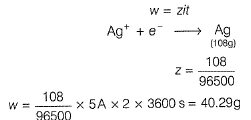

What product are formed during the electrolysis of a concentrated aqueous solution of sodium chloride using an electrolytic cell in which electrodes are separated by a porous pot?I. Cl2(g)
II. NaOH(aq)
III. H2(g)
IV. NaClO(aq)
V. NaClO3(aq) Select the correct choice. - a)I and II
- b)I , II and V
- c)I , IiI and V
- d)I , II and III
Correct answer is option 'D'. Can you explain this answer?
What product are formed during the electrolysis of a concentrated aqueous solution of sodium chloride using an electrolytic cell in which electrodes are separated by a porous pot?
I. Cl2(g)
II. NaOH(aq)
III. H2(g)
IV. NaClO(aq)
V. NaClO3(aq)
II. NaOH(aq)
III. H2(g)
IV. NaClO(aq)
V. NaClO3(aq)
Select the correct choice.
a)
I and II
b)
I , II and V
c)
I , IiI and V
d)
I , II and III

|
Anoushka Chopra answered |

Cl2(g) is formed at anode and NaOH and H2 are formed at cathode. Since, cathode and anode are separated. Hence. there is no reaction between the products formed at the cathode and anode.

Note: but these reaction do not occur
Note: NaCl is neutral pH = 7 initially. After electrolysis , NaOH is formed
Hence, solution become, basic pH >7
Which pair of electrolysis could be distinguished by the products of electrolysis using inert electrodes?- a)1 M CuSO4 ,1 M CuCl2
- b)1 M KCl ,1 M KI
- c)1 M AgNO3 ,1 M CuSO4
- d)1 M CuBr2 , 1 M NiBr2
Correct answer is option 'B,C'. Can you explain this answer?
Which pair of electrolysis could be distinguished by the products of electrolysis using inert electrodes?
a)
1 M CuSO4 ,1 M CuCl2
b)
1 M KCl ,1 M KI
c)
1 M AgNO3 ,1 M CuSO4
d)
1 M CuBr2 , 1 M NiBr2

|
Asha Nair answered |
a(Cu So4 and CuCl2 changes to Cu and solution becomes colourless
(b) KCl changes to Cl2 (yellow)
KI changes to I2 (voilet)
KI changes to I2 (voilet)
Thus, distinguished.
(c) AgNo3 No change
CuSo4 (blue) changes to colourless
(d) CuBr2 (blue) both changes to colourles.
NiBr2 (Blue)
Comprehension TypeThis section contains a passage describing theory, experiments, data, etc. Two questions related to the paragraph have been given. Each question has only one correct answer out of the given 4 options (a), (b), (c) and (d) Passage IA constant current of 30 A is passed through an aqueous solution of NaCl for a time of 1.00 h.Thus NaOH formed due to electrolysis is- a)40.2 g
- b)44.8 g
- c)31.1 g
- d)22.4 g
Correct answer is option 'B'. Can you explain this answer?
Comprehension Type
This section contains a passage describing theory, experiments, data, etc. Two questions related to the paragraph have been given. Each question has only one correct answer out of the given 4 options (a), (b), (c) and (d)
Passage I
A constant current of 30 A is passed through an aqueous solution of NaCl for a time of 1.00 h.
Thus NaOH formed due to electrolysis is
a)
40.2 g
b)
44.8 g
c)
31.1 g
d)
22.4 g
|
|
Tanvi Bose answered |
Electrolysis of NaCl Solution
Calculation of NaOH formed
In summary, passing a constant current of 30 A through an aqueous solution of NaCl for 1 hour will result in the production of NaOH and HCl due to electrolysis. To calculate the amount of NaOH formed, we use the formula mentioned above and plug in the given values. The correct answer is option 'B', which is 44.8 g of NaOH formed.
- A constant current of 30 A is passed through an aqueous solution of NaCl for 1 hour
- NaCl undergoes electrolysis and produces NaOH and HCl
- We need to calculate the amount of NaOH formed due to electrolysis
Calculation of NaOH formed
- The formula for calculating the amount of NaOH formed is:
- Amount of NaOH = (Current × Time × Atomic weight of Na × 1 mol of NaOH)/ (2 × Faraday's constant)
- Plugging in the values, we get:
- Amount of NaOH = (30 × 3600 × 23 × 1)/ (2 × 96500) = 44.8 g
- Therefore, the correct answer is option 'B'
In summary, passing a constant current of 30 A through an aqueous solution of NaCl for 1 hour will result in the production of NaOH and HCl due to electrolysis. To calculate the amount of NaOH formed, we use the formula mentioned above and plug in the given values. The correct answer is option 'B', which is 44.8 g of NaOH formed.
Schematic diagram of an electrolytic cell is- a)
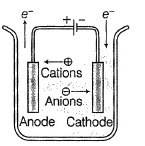
- b)
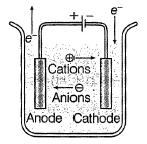
- c)
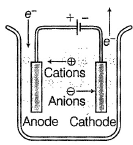
- d)None of these is the correct presentation
Correct answer is option 'B'. Can you explain this answer?
Schematic diagram of an electrolytic cell is
a)
b)
c)
d)
None of these is the correct presentation

|
Baishali Chakraborty answered |
In electrolytic cell,
Cation moves to cathode and anion moves to anode.
Electrons move anode to cathode.
When solving problems related to Faraday's laws of electrolysis, which quantity is used to determine the amount of chemical reaction that occurs?- a)Voltage
- b)Temperature
- c)Time
- d)Electric charge
Correct answer is option 'D'. Can you explain this answer?
When solving problems related to Faraday's laws of electrolysis, which quantity is used to determine the amount of chemical reaction that occurs?
a)
Voltage
b)
Temperature
c)
Time
d)
Electric charge
|
|
Deepak Iyer answered |
When solving problems related to Faraday's laws of electrolysis, the quantity of electric charge passed through the electrolyte is used to determine the amount of chemical reaction that occurs. Faraday's laws establish a relationship between the amount of substance produced or consumed during electrolysis and the quantity of electric charge passed. Therefore, option (d) is the correct answer.
An electrochemical cell was based on the following reaction:Mn(OH)2(s) + H2O2(aq) → MnO2(s) + 2H2O (e)During the opeartion of this for 1 min, 0.135 g of MnO2 was produced. What is the average electric current (in ampere ) produced by the cell?
Correct answer is '5'. Can you explain this answer?
An electrochemical cell was based on the following reaction:
Mn(OH)2(s) + H2O2(aq) → MnO2(s) + 2H2O (e)
During the opeartion of this for 1 min, 0.135 g of MnO2 was produced. What is the average electric current (in ampere ) produced by the cell?

|
Gauri Khanna answered |
Electroplating is an example of an application of electrolysis that involves:- a)Coating an object with a thin layer of metal
- b)Heating a liquid to produce a chemical reaction
- c)Measuring the flow of electric current
- d)Generating electricity from a chemical reaction
Correct answer is option 'A'. Can you explain this answer?
Electroplating is an example of an application of electrolysis that involves:
a)
Coating an object with a thin layer of metal
b)
Heating a liquid to produce a chemical reaction
c)
Measuring the flow of electric current
d)
Generating electricity from a chemical reaction
|
|
Deepak Iyer answered |
Electroplating is the process of coating an object with a thin layer of metal using electrolysis. It involves passing an electric current through a solution containing metal ions, causing the metal ions to deposit onto the object's surface. Therefore, option (a) is the correct answer.
An example of an application of conduction of electricity through gases is:- a)Production of fertilizers
- b)Air conditioning in buildings
- c)Neon signs
- d)Water purification
Correct answer is option 'C'. Can you explain this answer?
An example of an application of conduction of electricity through gases is:
a)
Production of fertilizers
b)
Air conditioning in buildings
c)
Neon signs
d)
Water purification
|
|
Deepak Iyer answered |
Neon signs are an example of an application of conduction of electricity through gases. Neon gas, when ionized by electric current, emits a characteristic color of light, which is utilized in neon signs for advertising purposes. Therefore, option (c) is the correct answer.
In the electrosynthesis,potassium manganate (VII) is converted to manganese(IV) dioxide. By passage of 1F of electrolysis ,one mole of potassium manganate(VII) will form manganese dioxide.- a)1.00 mol
- b)0.50 mol
- c)0.66 mol
- d)0.33 mol
Correct answer is option 'D'. Can you explain this answer?
In the electrosynthesis,potassium manganate (VII) is converted to manganese(IV) dioxide. By passage of 1F of electrolysis ,one mole of potassium manganate(VII) will form manganese dioxide.
a)
1.00 mol
b)
0.50 mol
c)
0.66 mol
d)
0.33 mol

|
Sinjini Tiwari answered |
Manganate (VII) is MnO4- with ON of Mn = + 7
1 mole required 3F of electricity thus, 1 F will reduce only (1/3) mole MnO4- t o MnO2.
Thus, MnO2 formed = 0.33 mol.
1 mole required 3F of electricity thus, 1 F will reduce only (1/3) mole MnO4- t o MnO2.
Thus, MnO2 formed = 0.33 mol.
Matching List TypeChoices for the correct combination of elements from Column I and Column II are given as options (a), (b), (c) and (d), out of which one is correctFour electrolytic cells containing solution of ZnSO4, AgNO3, CuSO4 and dil. H2SO4 are connected in series. A steady current of 1.5 A was passed through them until 77 mL of O2 gas at STP is formed in anode compartment of H2SO4 solution. Match the different elements/gas formed In Column I with their values in Column II and select the answer from the codes given below. (Cu = 63.5, Zn = 65, Ag = 108, S = 32, H = 1, 0 = 16)
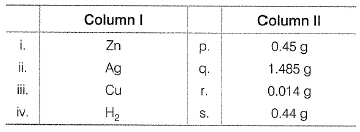 Codes i ii iii iv
Codes i ii iii iv - a)

- b)

- c)

- d)

Correct answer is option 'A'. Can you explain this answer?
Matching List Type
Choices for the correct combination of elements from Column I and Column II are given as options (a), (b), (c) and (d), out of which one is correct
Four electrolytic cells containing solution of ZnSO4, AgNO3, CuSO4 and dil. H2SO4 are connected in series. A steady current of 1.5 A was passed through them until 77 mL of O2 gas at STP is formed in anode compartment of H2SO4 solution. Match the different elements/gas formed In Column I with their values in Column II and select the answer from the codes given below. (Cu = 63.5, Zn = 65, Ag = 108, S = 32, H = 1, 0 = 16)
Codes i ii iii iv
a)

b)

c)

d)


|
Sinjini Tiwari answered |
According to Faraday's first law of electrolysis, the amount of chemical reaction during electrolysis is proportional to:- a)The voltage applied
- b)The concentration of the electrolyte
- c)The time of electrolysis
- d)The quantity of electric charge passed
Correct answer is option 'D'. Can you explain this answer?
According to Faraday's first law of electrolysis, the amount of chemical reaction during electrolysis is proportional to:
a)
The voltage applied
b)
The concentration of the electrolyte
c)
The time of electrolysis
d)
The quantity of electric charge passed
|
|
Deepak Iyer answered |
Faraday's first law of electrolysis states that the amount of chemical reaction that occurs during electrolysis is directly proportional to the quantity of electric charge passed through the electrolyte. Therefore, option (d) is the correct answer.
A hydrogen-oxygen fuel cell opeartes on the simple reaction:
 If the cell is designed to produce 1.46A of current and if the H2 is contained in a 1.0 L tank at 2.00 atm pressure at 298K, how long can the fuel cell operate(in hour) before the H2 runs out.(Assume unlimited supply of oxygen)
Correct answer is '3'. Can you explain this answer?
If the cell is designed to produce 1.46A of current and if the H2 is contained in a 1.0 L tank at 2.00 atm pressure at 298K, how long can the fuel cell operate(in hour) before the H2 runs out.(Assume unlimited supply of oxygen)
Correct answer is '3'. Can you explain this answer?
A hydrogen-oxygen fuel cell opeartes on the simple reaction:
If the cell is designed to produce 1.46A of current and if the H2 is contained in a 1.0 L tank at 2.00 atm pressure at 298K, how long can the fuel cell operate(in hour) before the H2 runs out.(Assume unlimited supply of oxygen)

|
Gauri Khanna answered |
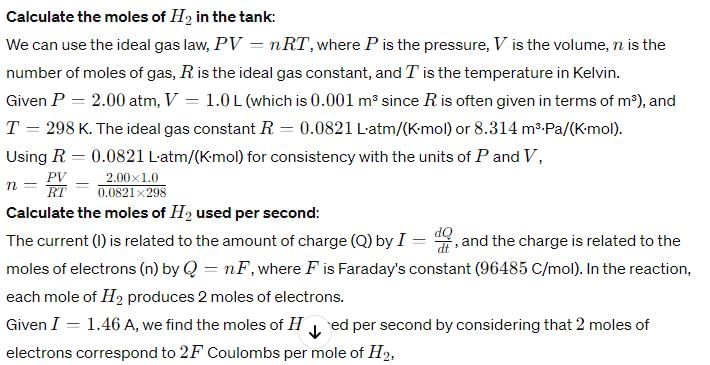
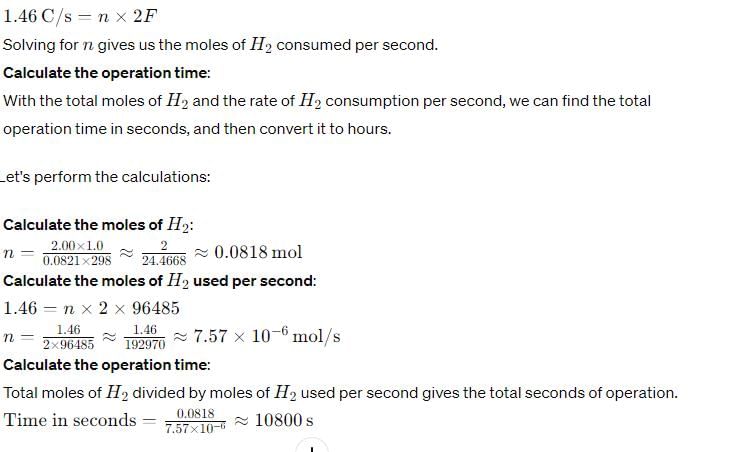

Which of the following gases is commonly used in electric bulbs?- a)Oxygen (O2)
- b)Nitrogen (N2)
- c)Carbon dioxide (CO2)
- d)Argon (Ar)
Correct answer is option 'D'. Can you explain this answer?
Which of the following gases is commonly used in electric bulbs?
a)
Oxygen (O2)
b)
Nitrogen (N2)
c)
Carbon dioxide (CO2)
d)
Argon (Ar)
|
|
Deepak Iyer answered |
Argon (Ar) is commonly used in electric bulbs. It is an inert gas that does not react with the filament and helps to prevent its degradation due to oxidation at high temperatures. Therefore, option (d) is the correct answer.
The main objective of distinguishing between electrolytes and non-electrolytes is to:- a)Understand the behavior of substances in the liquid state
- b)Determine the boiling point of a liquid
- c)Identify substances that can conduct electricity in solution
- d)Predict the freezing point of a liquid
Correct answer is option 'C'. Can you explain this answer?
The main objective of distinguishing between electrolytes and non-electrolytes is to:
a)
Understand the behavior of substances in the liquid state
b)
Determine the boiling point of a liquid
c)
Identify substances that can conduct electricity in solution
d)
Predict the freezing point of a liquid
|
|
Deepak Iyer answered |
The main objective of distinguishing between electrolytes and non-electrolytes is to identify substances that can conduct electricity in solution. Electrolytes dissociate into ions in solution, allowing them to carry electric charge. Non-electrolytes, on the other hand, do not dissociate into ions and cannot conduct electricity in solution. Therefore, option (c) is the correct answer.
The application of conduction of electricity through gases is commonly seen in:- a)Fuel combustion in cars
- b)Photosynthesis in plants
- c)The operation of electric heaters
- d)Lightning during a thunderstorm
Correct answer is option 'D'. Can you explain this answer?
The application of conduction of electricity through gases is commonly seen in:
a)
Fuel combustion in cars
b)
Photosynthesis in plants
c)
The operation of electric heaters
d)
Lightning during a thunderstorm
|
|
Deepak Iyer answered |
The application of conduction of electricity through gases is commonly seen in lightning during a thunderstorm. Lightning is a natural example of electrical discharge through gases. Therefore, option (d) is the correct answer.
Which of the following substances is an example of an electrolyte?- a)Distilled water
- b)Ethanol (C2H5OH)
- c)Sugar (C12H22O11)
- d)Acetone (CH3COCH3)
Correct answer is option 'B'. Can you explain this answer?
Which of the following substances is an example of an electrolyte?
a)
Distilled water
b)
Ethanol (C2H5OH)
c)
Sugar (C12H22O11)
d)
Acetone (CH3COCH3)
|
|
Deepak Iyer answered |
An electrolyte is a substance that conducts electricity when dissolved in water or molten. Among the given options, ethanol (C2H5OH) is an example of an electrolyte as it ionizes into ions (C2H5O-) and (H+) when dissolved in water, allowing it to conduct electricity.
One Integer Value Correct TypeThis section contains 6 questions, when worked out will result in an integer value from 0 to 9 (both inclusive)Mn+ solution was electrolysed for 75 min by a current of 0.30 A. Mass of the metal M deposited at the cathode was 9.958 g.Mn+ contains 68 protons and 69 neutrons. What is the value of n? - a)

- b)

- c)

- d)

Correct answer is '2'. Can you explain this answer?
One Integer Value Correct Type
This section contains 6 questions, when worked out will result in an integer value from 0 to 9 (both inclusive)
Mn+ solution was electrolysed for 75 min by a current of 0.30 A. Mass of the metal M deposited at the cathode was 9.958 g.Mn+ contains 68 protons and 69 neutrons. What is the value of n?
a)

b)

c)

d)


|
Nidhi Yadav answered |
One or More than One Options Correct TypeThis section contains 5 multiple type questions. Each question has 4 choices (a), (b), (c) and (d), out of which ONE or MORE THAN ONE are correct.Select the correct point(s) of distinction between a volatic cell and electrolysis cell.
- a)a
- b)b
- c)c
- d)d
Correct answer is option 'A,C,D'. Can you explain this answer?
One or More than One Options Correct Type
This section contains 5 multiple type questions. Each question has 4 choices (a), (b), (c) and (d), out of which ONE or MORE THAN ONE are correct.
Select the correct point(s) of distinction between a volatic cell and electrolysis cell.
a)
a
b)
b
c)
c
d)
d

|
Gauri Kaur answered |
(a.c.d) Regardlessvehether a cell is a volatic or an electrolysis cell, anode s the electrode at which oxidation takes place and cathode is the electrode at which reduction takes place. In electrochemical cell, Zn → Zn2+ + 2e- .
It is losing electrons thus, anode is negative terminal. In electrolysis cell. cation migrates to cathode thus -ye terminal. anion migrates to anode thus +ve terminal.
Discharge through gases refers to the:- a)Conversion of a gas into a solid
- b)Movement of electric current through a gas
- c)Release of gas from a container
- d)Decomposition of a gas into its elements
Correct answer is option 'B'. Can you explain this answer?
Discharge through gases refers to the:
a)
Conversion of a gas into a solid
b)
Movement of electric current through a gas
c)
Release of gas from a container
d)
Decomposition of a gas into its elements
|
|
Deepak Iyer answered |
Discharge through gases refers to the movement of electric current through a gas. When a high voltage is applied to a gas, it ionizes, and electric current can flow through the ionized gas. Therefore, option (b) is the correct answer.
Electrolysis is the process of:- a)Converting a liquid to a gas
- b)Separating a compound into its elements using electricity
- c)Mixing two or more liquids together
- d)Increasing the temperature of a liquid
Correct answer is option 'B'. Can you explain this answer?
Electrolysis is the process of:
a)
Converting a liquid to a gas
b)
Separating a compound into its elements using electricity
c)
Mixing two or more liquids together
d)
Increasing the temperature of a liquid
|
|
Deepak Iyer answered |
Electrolysis is the process in which an electric current is passed through an electrolyte (a liquid or molten compound) to bring about a chemical change. It involves the decomposition of a compound into its constituent elements. Therefore, option (b) is the correct answer.
Chapter doubts & questions for Conduction of Energy through Liquids & Gases - Physics for JAMB 2025 is part of JAMB exam preparation. The chapters have been prepared according to the JAMB exam syllabus. The Chapter doubts & questions, notes, tests & MCQs are made for JAMB 2025 Exam. Find important definitions, questions, notes, meanings, examples, exercises, MCQs and online tests here.
Chapter doubts & questions of Conduction of Energy through Liquids & Gases - Physics for JAMB in English & Hindi are available as part of JAMB exam.
Download more important topics, notes, lectures and mock test series for JAMB Exam by signing up for free.
Physics for JAMB
259 videos|253 docs|230 tests
|

Contact Support
Our team is online on weekdays between 10 AM - 7 PM
Typical reply within 3 hours
|
Free Exam Preparation
at your Fingertips!
Access Free Study Material - Test Series, Structured Courses, Free Videos & Study Notes and Prepare for Your Exam With Ease

 Join the 10M+ students on EduRev
Join the 10M+ students on EduRev
|

|
Create your account for free
OR
Forgot Password
OR
Signup to see your scores
go up
within 7 days!
within 7 days!
Takes less than 10 seconds to signup










